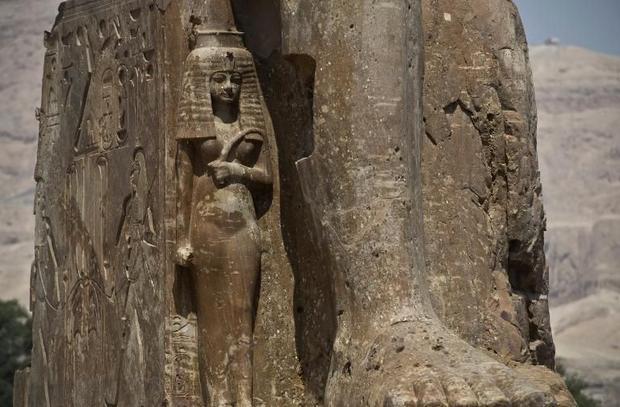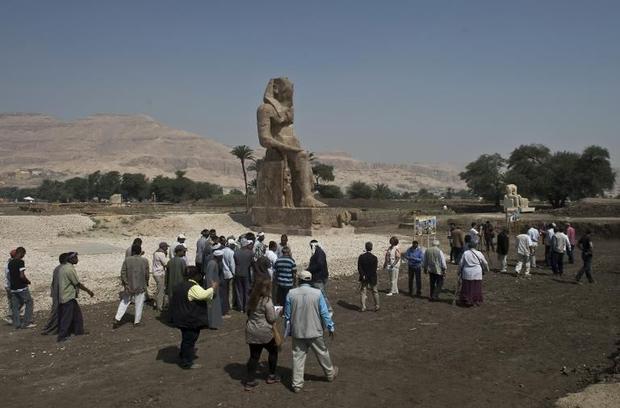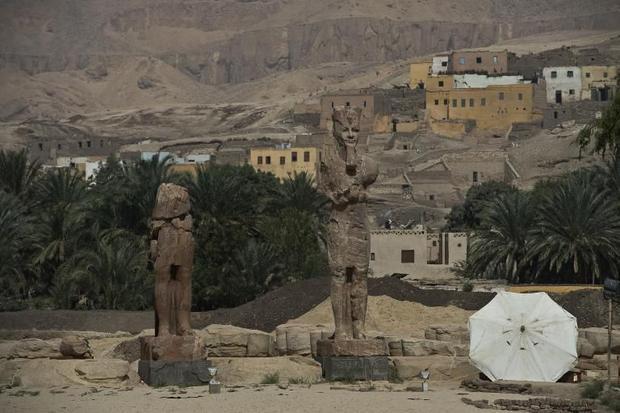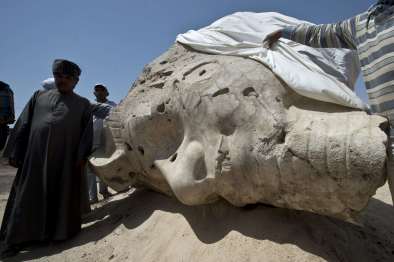Science
Two More Colossal Pharaoh Statues Unveiled in Egypt
The discovery of the two colossal statues is considered a rare one.
Archaeologists on Sunday unveiled two colossal statues of Pharaoh Amenhotep III in Egypts famed temple city of Luxor, adding to an existing pair of world-renowned tourist attractions.
The two monoliths in red quartzite were raised at what European and Egyptian archaeologists said were their original sites in the funerary temple of the king, on the west bank of the Nile.
The temple is already famous for its existing 3,400-year-old Memnon colossi twin statues of Amenhotep III whose reign archaeologists say marked the political and cultural zenith of ancient Egyptian civilisation.
The world until now knew two Memnon colossi, but from today it will know four colossi of Amenhotep III, said German-Armenian archaeologist Hourig Sourouzian, who heads the project to conserve the Amenhotep III temple.
The existing two statues, both showing the pharaoh seated, are known across the globe.
The two restored additions have weathered severe damage for centuries, Sourouzian said.

The statues had lain in pieces for centuries in the fields, damaged by destructive forces of nature like earthquake, and later by irrigation water, salt, encroachment and vandalism, she said, as behind her excavators and local villagers washed pieces of artefacts and statues unearthed over the past months.
This beautiful temple still has enough for us to study and conserve.
One of the new statues its body weighing 250 tonnes again depicts the pharaoh seated, hands resting on his knees.
It is 11.5 metres (38 feet) tall, with a base 1.5 metres high and 3.6 metres wide.
Archaeologists said with its now missing double crown, the original statue would have reached a height of 13.5 metres and weighed 450 tonnes.
The king is depicted wearing a royal pleated kilt held at the waist by a large belt decorated with zigzag lines.
Beside his right leg stands nearly a complete figure of Amenhotep IIIs wife Tiye, wearing a large wig and a long tight-fitting dress.

A statue of queen mother Mutemwya, originally beside his left leg, is missing, archaeologists said.
The throne itself is decorated on each side with scenes from that era, showing the unification of Upper and Lower Egypt.
The second statue, of Amenhotep III standing, has been installed at the north gate of the temple.
The team of archaeologists also showed several other ancient pieces of what they said were parts of other statues of the ancient ruler and his relatives, including a well-preserved alabaster head from another Amenhotep III statue.
This piece is unique, it is rare, because there are not many alabaster statues in the world, Sourouzian told AFP.
The head, shown briefly to some reporters and fellow excavators, has also weathered centuries of damage. Its nose, eyes and ears are intact, and some signs of restoration centuries ago are clearly evident, archaeologists said. Close to the head lies a statue of Princess Iset, Amenhotep IIIs daughter.
Sourouzian said the aim of her teams work was to preserve these monuments and the temple itself, which according to her had suffered at the hands of nature and mankind.
Every ruin, every monument has its right to be treated decently, said Sourouzian, whose dream as a student was to conserve the Amenhotep III temple.

The idea is to stop the dismantling of monuments and keep them at their sites, she said, adding that what was required was steady international funding to conserve such world heritage sites.
The ongoing work to conserve the Amenhotep III temple is entirely funded through what she said were private and international donations.
Pharaoh Amenhotep III inherited an empire that spanned from the Euphrates to Sudan, archaeologists say, and he was able to maintain Egypts position mainly through diplomacy.
The 18th dynasty ruler became king at the age of around 12, with his mother as regent.
Amenhotep III died in around 1354 BCE and was succeeded by his son Amenhotep IV, widely known as Akhenaten.
Luxor, a city of some 500,000 people on the banks of the Nile in southern Egypt, is an open-air museum of intricate temples and pharaonic tombs.
Source:
asheepnomore.net

